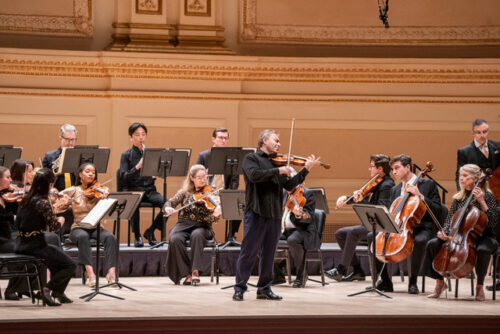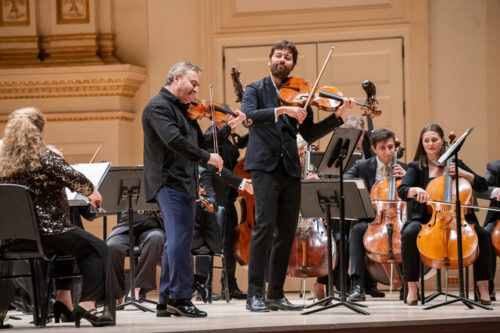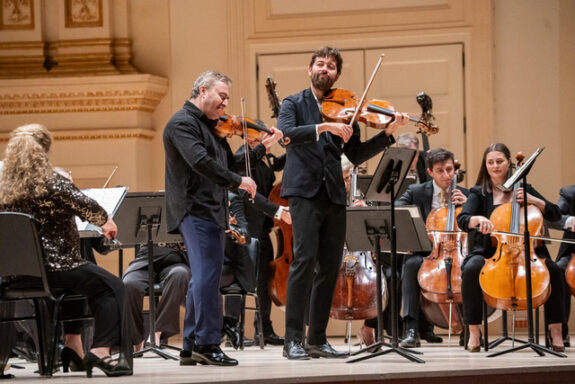 United States Mozart: Maxim Vengerov (violin), Lawrence Power (viola), Orpheus Chamber Orchestra. Carnegie Hall, New York, 7.11.2024. (RP)
United States Mozart: Maxim Vengerov (violin), Lawrence Power (viola), Orpheus Chamber Orchestra. Carnegie Hall, New York, 7.11.2024. (RP)

Mozart – Violin Concerto No.2 in D major, K.211; Violin Concerto No.5 in A major, K.219, ‘Turkish’; Sinfonia Concertante in E-flat major for Violin and Viola, K.364
Violinist Maxim Vengerov began his three-year Carnegie Hall Perspective series with two concerts devoted to Mozart’s compete works for violin and orchestra. This, the second of the two, featured pieces that Mozart composed from 1775 to 1780. It was a remarkable period of development for the young composer, who was just 19 years old in 1775 when he pumped out four violin concerti in one year.
Conforming to the custom of Mozart’s day, Vengerov performed both as soloist and conductor. His collaborators were the Orpheus Chamber Orchestra, which is known for working with musicians of all stripes, and proud of the fact that it has never had any use for a conductor. Little was thus required of Vengerov in the latter regard but to occasionally cue an entrance, shape a phrase or provide a dynamic shading. Orpheus gave Vengerov free rein to do what he does best: play the violin.
The Violin Concerto No.2 is a charming, lighthearted work, which is of interest primarily as a musical steppingstone on Mozart’s path to maturity as a composer. There is little of the musical complexity, fascinating textures or dramatic intensity that would be found in his mature works. Intended as courtly entertainment with its composer as soloist, this performance by Vengerov and Orpheus fulfilled such expectations with grace and impeccable musicianship, as well as a fair amount of virtuosity from the violinist.
As he would in the Violin Concerto No.5 which came next on the program, Vengerov played his own versions of the cadenzas. The one in the first movement of the Concerto No.2 was a perfect union of period style fused with modern verve. Just as Mozart injected humor into the music, so did Vengerov in this cadenza, prompting more than a smile or two in the audience.
Mozart composed his First Violin Concerto in 1773, with the remaining four authenticated ones, Nos. 2 through 5, composed two years later. Violin Concerto No.5, dubbed the ‘Turkish’ due to the ‘wild’ music in the third movement, is a cut above the others in terms of sophistication, especially the musical surprises with which Mozart peppered it.
In the final one, Mozart’s command of writing for an orchestra also advanced, which Orpheus readily demonstrated. In the first movement, there were some particularly exciting passages for the horns, while in the second the orchestra’s playing pulsated with the tension Mozart wove into the music. The eventual release of such emotions brought pleasures of their own, especially in the sense of equipoise that the orchestra achieved at such moments.
In the last movement, after the measured frenzy of the ‘Turkish’ dance, the concerto ended with the most graceful of turns, as if a zephyr lifted the music skywards. Vengerov was largely responsible for conjuring the magic in that musical gesture.

The Sinfonia Concertante K.364 is the apex, as well as the culmination, of his works for solo violin. He was introduced to the genre in Paris, but hearing the magnificent orchestra in Mannheim, one of the best in Europe, also fueled his imagination. He started six works in this genre for different combinations of instruments while in Paris in 1778. It took only a few measures to realize this was Mozart of a far different sort than had been heard in the two works performed in the first half of the concert. Although Don Giovanni was still several years off, the Sinfonia Concertante has far greater emotional depth – perhaps due to the death of Mozart’s mother – and already pointed towards the marriage of music and emotion that would soon be his to command in one of his greatest operas.
Mozart envisioned the Sinfonia Concertante as a dialogue not only between the soloists, but also one that extended to their relationship to the orchestra. Violist Lawrence Power and Vengerov are an established team whose complementary stylistic differences enriched the performance. The violinist took a more classical style to the music, while the violist assumed a more relaxed, often contemplative approach, coupled with a touch of insouciance. When they playing together, Vengerov’s glorious, rich sound blended perfectly with Powers’s equally robust but mellower tone.
Their artistry was on prime display in the cadenzas of the first and second movements. The playing was joyful in the former, while in the latter it was soft and wistful. Such sentiments were fleeting, however: jubilation predominated, especially in their bravura playing in the third movement. That spirit carried over to their interaction with the orchestra, especially in the soloists’ engagement with the oboes and horns. The wonderful emotional tug and pull between all the musicians on the stage ended in great happiness and exhilaration for all.
Rick Perdian
